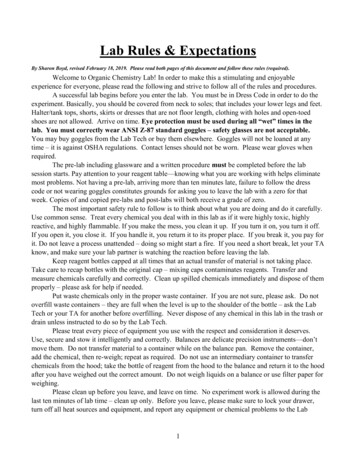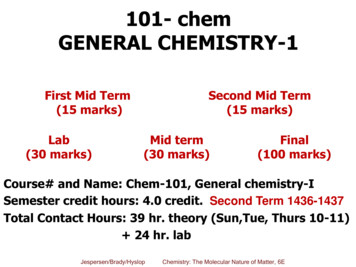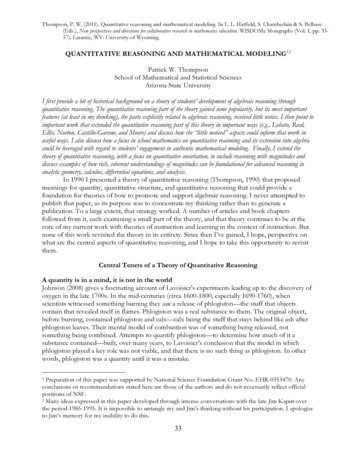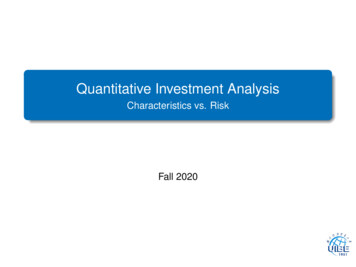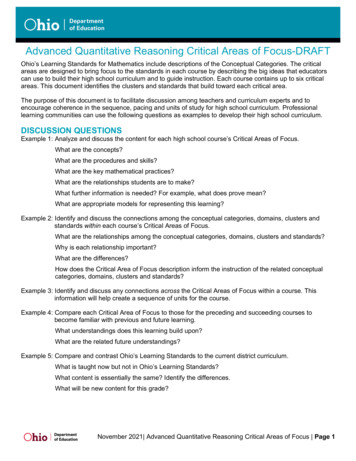
Transcription
Chapter 1: Basic tools of Analytical chemistryChem 232: Quantitative Analysis Lecture NotesScott Hu manJanuary 21, 2014Scott Hu manChem 232: Quantitative Analysis Lecture Notes
Chapter 1: Basic tools of Analytical chemistryTopic1Chapter 1: Basic tools of Analytical chemistryScott Hu manChem 232: Quantitative Analysis Lecture Notes
Chapter 1: Basic tools of Analytical chemistrySI units: French system 180 years oldBase timesecondselectrical currentampereAtemperatureKelvinKAmount of substancemolemolderived from SI base unitsdimensionunitsymbolSI alPasmkgs2kgNm2 or ms 2Scott Hu man1Chem 232: Quantitative Analysis Lecture Notes
Chapter 1: Basic tools of Analytical chemistrySI Units are base 10 (mostly):Conversion to common units is simpli edWhat is an exception?Time, which is base 60, 24, 365.25Scott Hu manChem 232: Quantitative Analysis Lecture Notes
Chapter 1: Basic tools of Analytical chemistrySI Units are base 10 (mostly):Conversion to common units is simpli edWhat is an exception?Time, which is base 60, 24, 365.25Scott Hu manChem 232: Quantitative Analysis Lecture Notes
Chapter 1: Basic tools of Analytical chemistrySI Units are base 10 (mostly):Conversion to common units is simpli edWhat is an exception?Time, which is base 60, 24, 365.25Scott Hu manChem 232: Quantitative Analysis Lecture Notes
Chapter 1: Basic tools of Analytical chemistrySI Units are base 10 (mostly):Conversion to common units is simpli edWhat is an exception?Time, which is base 60, 24, 365.25Scott Hu manChem 232: Quantitative Analysis Lecture Notes
Chapter 1: Basic tools of Analytical chemistrySI Units Pre xes:Pre xes can be used to simplify numberstable 1-3 in book (big)pre reviationYZEPTGMkhdaScott Hu man10N where N 242118151296321Chem 232: Quantitative Analysis Lecture Notes
Chapter 1: Basic tools of Analytical chemistrySI Unit Pre xes:table 1-3 in book (small)pre oabbreviationdcmµnpfazyScott Hu man10N where N -1-2-3-6-9-12-15-18-21-23Chem 232: Quantitative Analysis Lecture Notes
Chapter 1: Basic tools of Analytical chemistryExample: usage of pre xes in SI0.17 104 m 1.7kmand how do you know this?1km0.17 104 m 1000m 1.7kmScott Hu manChem 232: Quantitative Analysis Lecture Notes
Chapter 1: Basic tools of Analytical chemistryConcentration units and conversions:Concentration units and conversions: Here comes the de nitions!Scott Hu manChem 232: Quantitative Analysis Lecture Notes
Chapter 1: Basic tools of Analytical chemistryDe nition: solutionsolution:a homogeneous mixture of two or more substancesScott Hu manChem 232: Quantitative Analysis Lecture Notes
Chapter 1: Basic tools of Analytical chemistryDe nition: solutesolute:minor species in a solutionScott Hu manChem 232: Quantitative Analysis Lecture Notes
Chapter 1: Basic tools of Analytical chemistryDe nition: solventsolvent:major species in a solutionNOTE in aqueous solutions the solvent is waterwritten as (aq) in chemical reactions. For example *HCl(aq) H2 O(l) ) H3 O (aq) Cl (aq)NOTE can also be a system of chemicals (methanol and water)Scott Hu manChem 232: Quantitative Analysis Lecture Notes
Chapter 1: Basic tools of Analytical chemistryDe nition: analyteanalyte:species of interest in a mixture (implies a measurement)Scott Hu manChem 232: Quantitative Analysis Lecture Notes
Chapter 1: Basic tools of Analytical chemistryDe nition: concentrationconcentration:The ratio of solute contained in a given volume or mass of solutionor solventScott Hu manChem 232: Quantitative Analysis Lecture Notes
Chapter 1: Basic tools of Analytical chemistryDe nition: molemole:number of carbon atoms with mass of 0.012 kg 6.022141415 1023Scott Hu manChem 232: Quantitative Analysis Lecture Notes
Chapter 1: Basic tools of Analytical chemistryExample Problem: learing about the moledonutsingleScott Hu mancarbon atomsmolecules ofacetic acidChem 232: Quantitative Analysis Lecture Notes
Chapter 1: Basic tools of Analytical chemistryExample Problem: learing about the moledonutsingle1Scott Hu mancarbon atomsmolecules ofacetic acidChem 232: Quantitative Analysis Lecture Notes
Chapter 1: Basic tools of Analytical chemistryExample Problem: learing about the molesingledonutcarbon atoms11Scott Hu manmolecules ofacetic acidChem 232: Quantitative Analysis Lecture Notes
Chapter 1: Basic tools of Analytical chemistryExample Problem: learing about the molesinglepairdonutcarbon atoms11Scott Hu manmolecules ofacetic acid1Chem 232: Quantitative Analysis Lecture Notes
Chapter 1: Basic tools of Analytical chemistryExample Problem: learing about the molesinglepairdonutcarbon atoms121Scott Hu manmolecules ofacetic acid1Chem 232: Quantitative Analysis Lecture Notes
Chapter 1: Basic tools of Analytical chemistryExample Problem: learing about the molesinglepairdonutcarbon atoms1212Scott Hu manmolecules ofacetic acid1Chem 232: Quantitative Analysis Lecture Notes
Chapter 1: Basic tools of Analytical chemistryExample Problem: learing about the molesinglepaircoupledonutcarbon atoms1212Scott Hu manmolecules ofacetic acid12Chem 232: Quantitative Analysis Lecture Notes
Chapter 1: Basic tools of Analytical chemistryExample Problem: learing about the molesinglepaircoupledonutcarbon atoms12212Scott Hu manmolecules ofacetic acid12Chem 232: Quantitative Analysis Lecture Notes
Chapter 1: Basic tools of Analytical chemistryExample Problem: learing about the molesinglepaircoupledonutcarbon atoms122122Scott Hu manmolecules ofacetic acid12Chem 232: Quantitative Analysis Lecture Notes
Chapter 1: Basic tools of Analytical chemistryExample Problem: learing about the molesinglepaircoupledozendonutcarbon atoms122122Scott Hu manmolecules ofacetic acid122Chem 232: Quantitative Analysis Lecture Notes
Chapter 1: Basic tools of Analytical chemistryExample Problem: learing about the molesinglepaircoupledozendonutcarbon atoms12212122Scott Hu manmolecules ofacetic acid122Chem 232: Quantitative Analysis Lecture Notes
Chapter 1: Basic tools of Analytical chemistryExample Problem: learing about the molesinglepaircoupledozendonutcarbon atoms1221212212Scott Hu manmolecules ofacetic acid122Chem 232: Quantitative Analysis Lecture Notes
Chapter 1: Basic tools of Analytical chemistryExample Problem: learing about the molesinglepaircoupledozenbaker's dozendonutcarbon atoms1221212212Scott Hu manmolecules ofacetic acid12212Chem 232: Quantitative Analysis Lecture Notes
Chapter 1: Basic tools of Analytical chemistryExample Problem: learing about the molesinglepaircoupledozenbaker's dozendonutcarbon atoms122121312212Scott Hu manmolecules ofacetic acid12212Chem 232: Quantitative Analysis Lecture Notes
Chapter 1: Basic tools of Analytical chemistryExample Problem: learing about the molesinglepaircoupledozenbaker's dozendonutcarbon atoms12212131221213Scott Hu manmolecules ofacetic acid12212Chem 232: Quantitative Analysis Lecture Notes
Chapter 1: Basic tools of Analytical chemistryExample Problem: learing about the molesinglepaircoupledozenbaker's dozengrossdonutcarbon atoms12212131221213Scott Hu manmolecules ofacetic acid1221213Chem 232: Quantitative Analysis Lecture Notes
Chapter 1: Basic tools of Analytical chemistryExample Problem: learing about the molesinglepaircoupledozenbaker's dozengrossdonutcarbon atoms12212131441221213Scott Hu manmolecules ofacetic acid1221213Chem 232: Quantitative Analysis Lecture Notes
Chapter 1: Basic tools of Analytical chemistryExample Problem: learing about the molesinglepaircoupledozenbaker's dozengrossdonutcarbon atoms12212131441221213144Scott Hu manmolecules ofacetic acid1221213Chem 232: Quantitative Analysis Lecture Notes
Chapter 1: Basic tools of Analytical chemistryExample Problem: learing about the molesinglepaircoupledozenbaker's dozengrossmoledonutcarbon atoms12212131441221213144Scott Hu manmolecules ofacetic acid1221213144Chem 232: Quantitative Analysis Lecture Notes
Chapter 1: Basic tools of Analytical chemistryExample Problem: learing about the molesinglepaircoupledozenbaker's dozengrossmoledonutcarbon atoms12212131446.022 10231221213144Scott Hu manmolecules ofacetic acid1221213144Chem 232: Quantitative Analysis Lecture Notes
Chapter 1: Basic tools of Analytical chemistryExample Problem: learing about the molesinglepaircoupledozenbaker's dozengrossmoledonutcarbon atoms12212131446.022 102312212131446.022 1023Scott Hu manmolecules ofacetic acid1221213144Chem 232: Quantitative Analysis Lecture Notes
Chapter 1: Basic tools of Analytical chemistryExample Problem: learing about the molesinglepaircoupledozenbaker's dozengrossmoledonutcarbon atoms12212131446.022 102312212131446.022 1023Scott Hu manmolecules ofacetic acid12212131446.022 1023Chem 232: Quantitative Analysis Lecture Notes
Chapter 1: Basic tools of Analytical chemistryDe nition: Avogadro's NumberAvogadro's Number:this is the number in a moleshort hand NaScott Hu manChem 232: Quantitative Analysis Lecture Notes
Chapter 1: Basic tools of Analytical chemistryDe nition: Avogadro's NumberAvogadro's Number:this is the number in a moleshort hand NaScott Hu manChem 232: Quantitative Analysis Lecture Notes
Chapter 1: Basic tools of Analytical chemistryDe nition: Avogadro's NumberAvogadro's Number:this is the number in a moleshort hand NaScott Hu manChem 232: Quantitative Analysis Lecture Notes
Chapter 1: Basic tools of Analytical chemistryDe nition: Atomic MassMolar Atomic Mass:number of grams of an element containingScott Hu manNaatomsChem 232: Quantitative Analysis Lecture Notes
Chapter 1: Basic tools of Analytical chemistryDe nition: Molar MassMolar Mass:sum of the atomic masses of all the atoms in a moleculeabreviated MM herein.Scott Hu manChem 232: Quantitative Analysis Lecture Notes
Chapter 1: Basic tools of Analytical chemistryDe nition: MolarityMolarity:number of molecules or atoms or ions of a substance in moles perliter of solutionof substanceMolarity molesLiters of solutionsquare bracket notation[ H3 O ] these square brackets mean concentration in mole/literScott Hu manChem 232: Quantitative Analysis Lecture Notes
Chapter 1: Basic tools of Analytical chemistryDe nition: MolarityMolarity:number of molecules or atoms or ions of a substance in moles perliter of solutionof substanceMolarity molesLiters of solutionsquare bracket notation[ H3 O ] these square brackets mean concentration in mole/literScott Hu manChem 232: Quantitative Analysis Lecture Notes
Chapter 1: Basic tools of Analytical chemistryExample Problem: mass to molaritySeawater contains 2.7g of NaCl per 100 mL of seawater. What isthe molarity of NaCl in the ocean?HaveMass of NaCl and volume of solution Needmol/LDetermine Molar Mass (MM) of NaCl22.989768g/mol(MM of Na) 35.4527g/mol(MM of Cl)58.442468g/molUse MM to determine the moles of 2.7g NaCl 1molNaClmoles of NaCl 2.7g 0.046mol58.442468gNaClScott Hu manChem 232: Quantitative Analysis Lecture Notes
Chapter 1: Basic tools of Analytical chemistryExample Problem: mass to molarity (Continued)Seawater contains 2.7g of NaCl per 100 mL of seawater.Use the moles of NaCl and volume of solution to determinemolarityMolarity of NaCl 0.046 mol NaCl 0.46M100 10 3 L solutionScott Hu manChem 232: Quantitative Analysis Lecture Notes
Chapter 1: Basic tools of Analytical chemistryExample Problem: Molarity to massMgCl2 has a concentration of 0.045 M in the ocean. How manygrams of MgCl2 are present in 25 mL of seawater?First:Molar mass of MgCl2 24.305 g/mole Mg2(35.453 g/mole Cl) 95.211 g/mole MgCl2second:grams of MgCl2 in 25 mL of seawater (0.045 moles/L)(95.211 g/mole)(25 10 3 L) Scott Hu man0.11gChem 232: Quantitative Analysis Lecture Notes
Chapter 1: Basic tools of Analytical chemistryDe nition: ElectrolyteElectrolyte:a substance that dissociates into ions in solutionstrong: mostly disassociatesweak: partially dissociatesScott Hu manChem 232: Quantitative Analysis Lecture Notes
Chapter 1: Basic tools of Analytical chemistryExample: of electrolytesMgCl2 is a strong electrolyte in water70% of MgCl230% of MgCl2Mg2 2 Cl MgCl Cl NOTE there is, in reality, very little MgCl2 in the solutionScott Hu manChem 232: Quantitative Analysis Lecture Notes
Chapter 1: Basic tools of Analytical chemistryExample: of electrolytesMgCl2 is a strong electrolyte in water70% of MgCl230% of MgCl2Mg2 2 Cl MgCl Cl NOTE there is, in reality, very little MgCl2 in the solutionScott Hu manChem 232: Quantitative Analysis Lecture Notes
Chapter 1: Basic tools of Analytical chemistryDe nition: Formal ConcentrationFormal Concentration:molarity of electrolyte solutionsSo when we say concentration of MgCl2 in water is 0.054 M,what we really mean is that the formal concentration is0.054M.Scott Hu manChem 232: Quantitative Analysis Lecture Notes
Chapter 1: Basic tools of Analytical chemistryDe nition: Formal ConcentrationFormal Concentration:molarity of electrolyte solutionsSo when we say concentration of MgCl2 in water is 0.054 M,what we really mean is that the formal concentration is0.054M.Scott Hu manChem 232: Quantitative Analysis Lecture Notes
Chapter 1: Basic tools of Analytical chemistryDe nition: Formula MassFormula Mass:sum of all the atomic masses in the formulawhy have this?the molecular mass ( MM ) does not make sense for electrolytesbecausein water the molecule has broken up into ionsin the solid form the molecules are often not pure butcrystallized with water moleculesthis is called hydrated and the number of water molecules iscalled the hydration numberExample:NaNO3 · 5 H2 OScott Hu manChem 232: Quantitative Analysis Lecture Notes
Chapter 1: Basic tools of Analytical chemistryDe nition: Formula MassFormula Mass:sum of all the atomic masses in the formulawhy have this?the molecular mass ( MM ) does not make sense for electrolytesbecausein water the molecule has broken up into ionsin the solid form the molecules are often not pure butcrystallized with water moleculesthis is called hydrated and the number of water molecules iscalled the hydration numberExample:NaNO3 · 5 H2 OScott Hu manChem 232: Quantitative Analysis Lecture Notes
Chapter 1: Basic tools of Analytical chemistryDe nition: Coulomb's LawCoulomb's Law:opposite charges are attracted, same charges are repelledScott Hu manChem 232: Quantitative Analysis Lecture Notes
Chapter 1: Basic tools of Analytical chemistryDe nition: Electronegativityelectronegativity:scale of nuclear (positive) pull on electrons (negative).bonds formed by atoms of di erent electronegativity result inpolar bondsHF
Chapter 1: Basic tools of Analytical chemistryDe nition: Electronegativityelectronegativity:scale of nuclear (positive) pull on electrons (negative).bonds formed by atoms of di erent electronegativity result inpolar bondsHF2.14.0
Chapter 1: Basic tools of Analytical chemistryDe nition: Electronegativityelectronegativity:scale of nuclear (positive) pull on electrons (negative).bonds formed by atoms of di erent electronegativity result inpolar bondsδ H2.1δ F4.0Scott Hu manChem 232: Quantitative Analysis Lecture Notes
Chapter 1: Basic tools of Analytical chemistryDe nition: MolalityMolality (m):concentration unit inof solutem moleskg of solventScott Hu manChem 232: Quantitative Analysis Lecture Notes
Chapter 1: Basic tools of Analytical chemistryDe nition: MolalityMolality (m):concentration unit inof solutem moleskg of solventwhy:Scott Hu manChem 232: Quantitative Analysis Lecture Notes
Chapter 1: Basic tools of Analytical chemistryDe nition: MolalityMolality (m):concentration unit inof solutem moleskg of solventwhy:molarity changes with temp because volume changes with tempScott Hu manChem 232: Quantitative Analysis Lecture Notes
Chapter 1: Basic tools of Analytical chemistryDe nition: v %Percent by Volume:v% volume of solutevolume of total solution or mixtureScott Hu man 100Chem 232: Quantitative Analysis Lecture Notes
Chapter 1: Basic tools of Analytical chemistryExample: Everclear is 95 v % ethanol95 v % 95 mL ethanol100 mL Everclear 100%Scott Hu manChem 232: Quantitative Analysis Lecture Notes
Chapter 1: Basic tools of Analytical chemistryDe nition: wt%Percent by Weight:wt % mass of solutemass of total solution or mixtureScott Hu man 100Chem 232: Quantitative Analysis Lecture Notes
Chapter 1: Basic tools of Analytical chemistryExample Problem: wt% to molarity and molalityFind the molarity and molality of a 37.0 wt% solution of HCl inwater whose density is 1.19 g/mL.Havedensity, wt%other infowantmoles/LM.M. moles/kg solvent36.46 g/moleDe nition of MolarityM moles of HClL of solutionDe nition of wt %g of HCl0.37g HClwt % 100% 37.0wt % 100%g of solution1.00g solution {z}arbitraryScott Hu manChem 232: Quantitative Analysis Lecture Notes
Chapter 1: Basic tools of Analytical chemistryExample Problem: wt% to molarity and molality (continued)Find the molarity and molality of a 37.0 wt% solution of HCl inwater whose density is 1.19 g/mL.convert g of solution L of solution 1.19g sol.1000 mL0.37g HClg HCl 440.31.00g sol.1.00mL sol.1LL sol.{z} {z} from de nition abovedensityconvert g of HCl to moles of HCl g of HCl1 mole HClMolarity 440.3 12.1ML of solution36.46g HClScott Hu manChem 232: Quantitative Analysis Lecture Notes
Chapter 1: Basic tools of Analytical chemistryExample Problem: wt% to molarity and molality(continued2)Find Molality of the same solutionremember the de nition of molaitymoles of HClmolality kg of waterpick a mass of solution (because one is not given, it can beany convenient mass) such as 1 g of solution. Therefore,1 g of solution 0.37 g of HCl X g of water.whereX 1 g - 0.37 g 0.63 g of water.convert g of HCl to moles of HCl 1 mole HClmolality 0.37g HCl 0.010148 moles HCl36.46 g HCl 0.010148moles HClmolality 16.1m0.63 10 3 k gScott Hu manChem 232: Quantitative Analysis Lecture Notes
Chapter 1: Basic tools of Analytical chemistryDe nition: ppm and ppbppm or ppb:mass of solute6ppm massof sample 10 (µg/g)mass of solute9ppb massof sample 10 (ng/g)note: similarity between wt % (pph) and ppm and ppbAssumption: ppm and ppb in water solutions are very lowconcentrationsthe density of the solution is therefore very close to the densityof pure waterso with density 1.0 g/mLScott Hu manChem 232: Quantitative Analysis Lecture Notes
Chapter 1: Basic tools of Analytical chemistryDerivation of ppm and ppb:ppm µgppb Lµgg 1.00gmg1mg1000mL mLL1000µgL {z } assumed densityScott Hu manChem 232: Quantitative Analysis Lecture Notes
Chapter 1: Basic tools of Analytical chemistryDerivation of ppm and ppb:ppm µgppb Lµgg 1.00gmg1mg1000mL mLL1000µgL {z } assumed densityScott Hu manChem 232: Quantitative Analysis Lecture Notes
Chapter 1: Basic tools of Analytical chemistryExample Problem: ppb to molarityFind the concentration in molarity of 34 ppb hexane in water(MMhexane 86 g/mole)Remember your de nition of ppb. 34ppb 34µgLconvert µgto moles 1g1mol34µg 3.95 10 7 M106 µg86g {z }MMhexaneor 0.395 µMScott Hu manChem 232: Quantitative Analysis Lecture Notes
Chapter 1: Basic tools of Analytical chemistrypreparing solutions:The reason that we have molarity as a concentration unit is becauseof the way that solutions are prepared using Volumetric Flasks.Scott Hu manChem 232: Quantitative Analysis Lecture Notes
Chapter 1: Basic tools of Analytical chemistryExample: How to use a Volumetric Flask to make a solutionfrom a solidasktaskYou need 500 mL solution containing 10 mMCa2 . In your stockroom you have a kilogramof calcium nitrate pentahydrate(Ca(NO3 )2 · 5 H2 O).Here are your stepsCalculate the mass neededweigh out close to that amount (recordactual mass)Figure: Volumetricmake solutionFlaskScott Hu manChem 232: Quantitative Analysis Lecture Notes
Chapter 1: Basic tools of Analytical chemistryExample: How to use a volumetric ask to make solutionfrom a soliddetermine the number of moles of Ca 2 needed. 1M 2 0.01M10mM Ca103 mM0.01 moleL0.500L 5.0 10 3 moles Ca 2Determine how many moles of Ca(NO3 )2 · 5 H2 O are neededfrom the dissociation reaction. 2 *Ca(NO3 )2 · 5 H2 O(s) ) Ca 2 NO3 (aq) 5 H2 O5.0 10 3 moles Ca 21mole Ca(NO3 )2 ·5 H2 O1mole Ca 2Scott Hu man! 3 5.0 10moles Ca(NO3 )2 ·5 H2 OChem 232: Quantitative Analysis Lecture Notes
Chapter 1: Basic tools of Analytical chemistryExample: How to use a volumetric ask to make solutionfrom a solidDetermine the number of grams needed.5.0 10 3moles Ca(NO3 )2 ·5 H2 O 254.08g {zFW}mole 1.27gMeasure (weigh) out close to that amount (record actualmass).Let's pretend it is 1.3000 g of Ca(NO3 )2 · 5 H2 O.make solutionScott Hu manChem 232: Quantitative Analysis Lecture Notes
Chapter 1: Basic tools of Analytical chemistryExample: How to use a Volumetric Flask to make a solutionfrom a solidFinally, calculate the actual concentration (remember that youmeasured 1.3000 g).g Ca(NO3 )2 ·5 H2 O1 3000 .5 1165 1 FWmole1 mole1 10 3 moles Ca 2 0.500L sol.Scott Hu man 5.1165 10 3 moles Ca 2 0.0102MChem 232: Quantitative Analysis Lecture Notes
Chapter 1: Basic tools of Analytical chemistryExample: How to use a volumetric ask to make a moredilute solution from a more concentrated solution.Ex. you have a solution of 12.1 M HCl, but you need 1 L of 0.100M HCl.Ci Viuse the dilution equation Cf Vfmake a tableCi Vi Cf Vf 12.1 M?0.100 M1Lyou do not know Vi , so solve the dilution equation for Vi1M )(1L)Vi CfCVi f (0.12 8.264 10 3 L.1MScott Hu manChem 232: Quantitative Analysis Lecture Notes
Chapter 1: Basic tools of Analytical chemistryExample: solution dilution (continued)so you take 8 mL out of your 12.1 M HCl solution and put it in avolumetric ask.Next you ll the ask to about 1 cm from the ll line with yoursolventmix the samplell to the line with your solventnow you need to calculate the actual concentration of yourdiluted solution, because you actually only transferred 8 ml ofconcentrated HCl.Scott Hu manChem 232: Quantitative Analysis Lecture Notes
Chapter 1: Basic tools of Analytical chemistryExample: solution dilution (continued)so you take 8 mL out of your 12.1 M HCl solution and put it in avolumetric ask.Next you ll the ask to about 1 cm from the ll line with yoursolventmix the samplell to the line with your solventnow you need to calculate the actual concentration of yourdiluted solution, because you actually only transferred 8 ml ofconcentrated HCl.Scott Hu manChem 232: Quantitative Analysis Lecture Notes
Chapter 1: Basic tools of Analytical chemistryExample: solution dilution (continued)so you take 8 mL out of your 12.1 M HCl solution and put it in avolumetric ask.Next you ll the ask to about 1 cm from the ll line with yoursolventmix the samplell to the line with your solventnow you need to calculate the actual concentration of yourdiluted solution, because you actually only transferred 8 ml ofconcentrated HCl.Scott Hu manChem 232: Quantitative Analysis Lecture Notes
Chapter 1: Basic tools of Analytical chemistryExample: solution dilution (continued)so you take 8 mL out of your 12.1 M HCl solution and put it in avolumetric ask.Next you ll the ask to about 1 cm from the ll line with yoursolventmix the samplell to the line with your solventnow you need to calculate the actual concentration of yourdiluted solution, because you actually only transferred 8 ml ofconcentrated HCl.Scott Hu manChem 232: Quantitative Analysis Lecture Notes
Chapter 1: Basic tools of Analytical chemistryExample: solution dilution (continued)so you take 8 mL out of your 12.1 M HCl solution and put it in avolumetric ask.Next you ll the ask to about 1 cm from the ll line with yoursolventmix the samplell to the line with your solventnow you need to calculate the actual concentration of yourdiluted solution, because you actually only transferred 8 ml ofconcentrated HCl.Scott Hu manChem 232: Quantitative Analysis Lecture Notes
Chapter 1: Basic tools of Analytical chemistryExample: solution dilution (continued)so you take 8 mL out of your 12.1 M HCl solution and put it in avolumetric ask.Next you ll the ask to about 1 cm from the ll line with yoursolventmix the samplell to the line with your solventnow you need to calculate the actual concentration of yourdiluted solution, because you actually only transferred 8 ml ofconcentrated HCl.Scott Hu manChem 232: Quantitative Analysis Lecture Notes
Chapter 1: Basic tools of Analytical chemistryExample: solution dilution continuedmake a tableCi Vi Cf Vf 12.1 M8 mL?1 mLyou do not know Cf , so solve the dilution equation for Cf1M )(8mL)Cf CVi Vf i (12.1000mL 0.097 MScott Hu manChem 232: Quantitative Analysis Lecture Notes
Chapter 1: Basic tools of Analytical chemistryAnalytical Calculations based upon stoichiometry:Generally, this is the application of limiting reagent.Scott Hu manChem 232: Quantitative Analysis Lecture Notes
Chapter 1: Basic tools of Analytical chemistryExample: Gravimetric AnalysisWhat is the concentration of lead in the solution?Sodium chloride is added to a solution of {Pb 2 }. Assuming thatthe following reaction is the only one, and that the reaction goes tocompletion, what was the concentration in ppm of lead(II) in thesolution?Given the RXNPb 2 2 Cl PbCl2 (s)you lter out the ppt and the solid weighs 0.0004g.Scott Hu manChem 232: Quantitative Analysis Lecture Notes
Chapter 1: Basic tools of Analytical chemistryExample: Gravimetric Analysis (continued)Pb 2 2 Cl PbCl2 (s) {z }mass 0.0004 gWhat was the concentration of lead in the solution before theaddition of Cl in a sample whose volume was of 250 mL. 1 mole PbCl20.0004g PbCl2 1.43834 10 6278.068 g PbCl2 {z} moles PbCl2FW of PbCl2. 101 43834. 61 43834 10moles PbCl2 6moles Pb 2 moles Pb 2moles PbCl2 1.43834 10 6 moles Pb 2 . g Pb 2 2.98012 10 4 g Pb 2mole Pb 2{z}207 19MM of Pb 2Scott Hu manChem 232: Quantitative Analysis Lecture Notes
Chapter 1: Basic tools of Analytical chemistryExample: Gravimetric Analysis (continued)rememberµgL 6 2 10 µgppm 2.98012 10 4g Pbg10.250L 1192ppmor 1.2 Ö 103 ppmScott Hu manChem 232: Quantitative Analysis Lecture Notes
Chapter 1: Basic tools of Analytical chemistry SI Units Pre xes: Pre xes can be used to simplify numbers table 1-3 in book (big) pre x abbreviation 10 N where N yotta Y 24 zetta Z 21 exa E 18 peta P 15 tera T 12 giga G 9 mega M 6 kilo k 3 hecto h 2 deca da 1 unit Scott Hu man Chem

